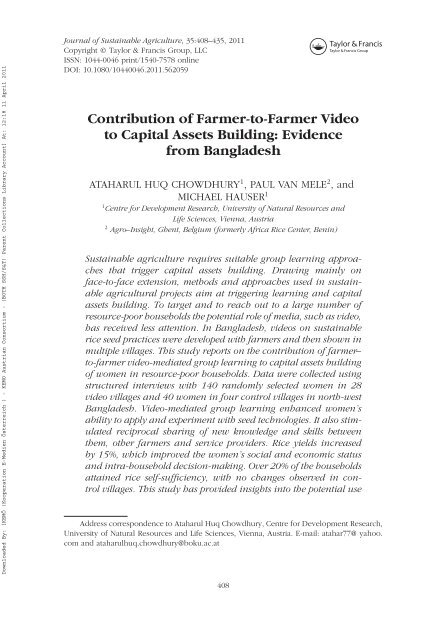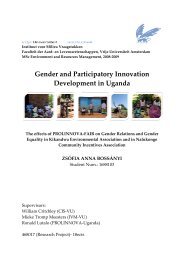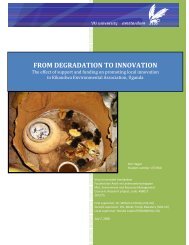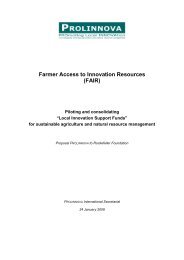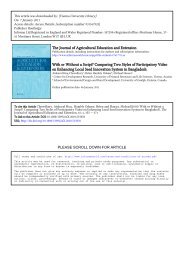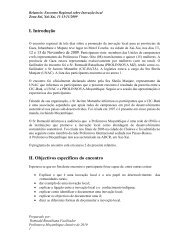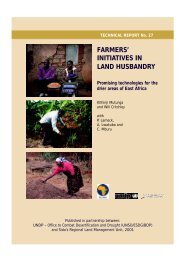Chowdhury et al (2011); PDF file - Prolinnova
Chowdhury et al (2011); PDF file - Prolinnova
Chowdhury et al (2011); PDF file - Prolinnova
Create successful ePaper yourself
Turn your PDF publications into a flip-book with our unique Google optimized e-Paper software.
Downloaded By: [KEMÖ (Kooperation E-Medien Österreich ) - KEMO Austrian Consortium - (BOTH SSH/S&T) Parent Collections Library Account] At: 12:18 11 April <strong>2011</strong><br />
Journ<strong>al</strong> of Sustainable Agriculture, 35:408–435, <strong>2011</strong><br />
Copyright © Taylor & Francis Group, LLC<br />
ISSN: 1044-0046 print/1540-7578 online<br />
DOI: 10.1080/10440046.<strong>2011</strong>.562059<br />
Contribution of Farmer-to-Farmer Video<br />
to Capit<strong>al</strong> Ass<strong>et</strong>s Building: Evidence<br />
from Bangladesh<br />
ATAHARUL HUQ CHOWDHURY 1 , PAUL VAN MELE 2 ,and<br />
MICHAEL HAUSER 1<br />
1 Centre for Development Research, University of Natur<strong>al</strong> Resources and<br />
Life Sciences, Vienna, Austria<br />
2 Agro–Insight, Ghent, Belgium (formerly Africa Rice Center, Benin)<br />
Sustainable agriculture requires suitable group learning approaches<br />
that trigger capit<strong>al</strong> ass<strong>et</strong>s building. Drawing mainly on<br />
face-to-face extension, m<strong>et</strong>hods and approaches used in sustainable<br />
agricultur<strong>al</strong> projects aim at triggering learning and capit<strong>al</strong><br />
ass<strong>et</strong>s building. To targ<strong>et</strong> and to reach out to a large number of<br />
resource-poor households the potenti<strong>al</strong> role of media, such as video,<br />
has received less attention. In Bangladesh, videos on sustainable<br />
rice seed practices were developed with farmers and then shown in<br />
multiple villages. This study reports on the contribution of farmer–<br />
to-farmer video-mediated group learning to capit<strong>al</strong> ass<strong>et</strong>s building<br />
of women in resource-poor households. Data were collected using<br />
structured interviews with 140 randomly selected women in 28<br />
video villages and 40 women in four control villages in north-west<br />
Bangladesh. Video-mediated group learning enhanced women’s<br />
ability to apply and experiment with seed technologies. It <strong>al</strong>so stimulated<br />
reciproc<strong>al</strong> sharing of new knowledge and skills b<strong>et</strong>ween<br />
them, other farmers and service providers. Rice yields increased<br />
by 15%, which improved the women’s soci<strong>al</strong> and economic status<br />
and intra-household decision-making. Over 20% of the households<br />
attained rice self-sufficiency, with no changes observed in control<br />
villages. This study has provided insights into the potenti<strong>al</strong> use<br />
Address correspondence to Ataharul Huq <strong>Chowdhury</strong>, Centre for Development Research,<br />
University of Natur<strong>al</strong> Resources and Life Sciences, Vienna, Austria. E-mail: atahar77@ yahoo.<br />
com and ataharulhuq.chowdhury@boku.ac.at<br />
408


